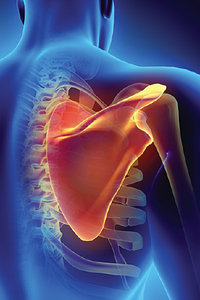The scapula is an incredible display of elegance and movement within the biomechanics of human motion. It's evolved for mobility and stability in the scapulo-thoracic region, giving us the ability to do things that are uniquely human, such as throwing with accuracy.
In essence, it's a delicate balance between mobility and stability. What is mobility? Mobility is the ability to move. What is stability? Stability is the ability to resist movement. Too much stability leads to poor mobility.
Interestingly, the shoulder is the first load-bearing joint in the body. It functions on the ground first. Think of a baby up on its elbows and then moving to crawling, rocking and creeping. This developmental sequence is one of the primary mechanisms we need to rediscover in shoulder rehabilitation. We move the body around the shoulder first, as opposed to the shoulder around the body.
Critical Fascial Bridges of the Scapula
 Thoracolumbar fascia connection of the posterior oblique subsystem, linking the latissimus dorsi to the opposite-side gluteus maximus.
Thoracolumbar fascia connection of the posterior oblique subsystem, linking the latissimus dorsi to the opposite-side gluteus maximus.
Rhombo-serratus (rhomboids and serratus anterior) connection to the subscapularis muscle as part of the spiral line of fascia (from Thomas Myers' work in his groundbreaking book, Anatomy Trains).
Muscles must work in three phases: concentric, isometric and eccentric. Scapular stabilization is based on the neural communication between the muscular and fascial systems. The scapula doesn't articulate to the torso; it's suspended by muscle and fascia. When a group of muscles contract during acceleration (concentric), another set of muscles must work opposite to lengthen and have deceleration (eccentric) control of motion. It's a synergistic and antagonistic patterning relationship.
For example, shrugging your shoulder toward your ears elevates the scapula by contraction of the upper trap, levator scapula and rhomboids. The pec minor, serratus anterior and lower trapezius eccentrically lengthen to control the motion.
What happens if this relationship becomes dysfunctional? What if the depressors are weak and inhibited? There is nothing to counterbalance the contraction (acceleration) of the elevators. They become dominant and painful, changing overall posture, thoracic spine mobility and shoulder mechanics.
| Scapular Function: An Anatomy Lesson Let's review some of the muscular and fascial structures that are critical to scapular function. We know everything in the body is connected and there is no break in the continuity of living matter. If it connects together, it patterns together. Patterning is motor control. Scapular Elevation |
It's not enough just to do soft-tissue release and mobilization; we must teach the brain what to do with all that restored range of motion. Here's a simple system to implement into your shoulder rehab program.
Let's use an example: You do a postural and movement assessment of the right shoulder and determine the scapula is depressed. The patient experiences pain when raising the arm into horizontal abduction.
This motion requires adequate elevation and upward rotation of the scapula. If these are not working efficiently, a compensation is often overuse of the glenohumeral joint, laterally flexing the head to the right and side-bending the torso to the left to find more motion: a full-body adaptation pattern.
Step 1: Soft-tissue fascial and muscular release, combined with necessary joint mobilization to the surrounding area.
Step 2: Manually release the scapular depressors and downward rotators by hand or using instrument-assisted soft-tissue manipulation, with slow and deep pressure to tolerance. This activates the Ruffini mechanoreceptors to inhibit or down-regulate neural input. Slow, deep-tissue techniques tend to have a relaxing effect on local tissues as well as the whole organism.
Also release the thoracolumbar fascia at T12-L1, bridging into the right latissimus and left gluteus maximus for the posterior oblique subsystem.
Step 3: Activate the elevators and upward rotators of the scapula by fast perturbation (tapping) on the muscles, starting from origin and insertion toward the center of the muscle. Remember motor control and perception? This technique stimulates the Pacinian mechanoreceptors for muscle activation and up-regulation. These receptors are primarily responsive to rapid pressure changes. Stimulating these receptors can result in improved proprioceptive feedback and controlled motor movement.
Step 4: Integrate the shoulder with the rest of the body on the ground in what's known as the sphinx position. The ground is beneficial because it adds more points of stabilization. Multiple points of stabilization allow greater force production.
Stability always precedes force production. What is force production? Strength. Do both sides. Perform five repetitions bilaterally.
Integrate with banded circles in tall and half-kneeling positions. Movement is based on circles, spirals and rotations.
The key is to not grip the bands with your hands. Wrap them around your wrist. Perform five repetitions in each position.
Helpful Tips
If you do the system and the patient's symptoms persist, treat the opposite shoulder. Often working on the better side helps the symptomatic one. Remember, everything is connected.
You also can assess the opposite-side hip for functioning. Poor eccentric control of hip flexion may cause overuse of the shoulder for stabilization.
By the way, this system also can work for other scapular dysfunctions, such as a protracted or elevated scapula.
Top 3 Takeaways
- Motor control is the cake mix of recovery. It's fundamental.
- Release tissue and then teach the body what to do with the restore motion.
- Think globally when evaluating shoulder problems, with the scapula ground zero.
Resources
- Beach P. Muscles and Meridians: The Manipulation of Shape. Edinburgh: Churchill Livingstone, 2010.
- Cook G. Movement: Functional Movement Systems: Screening, Assessment, and Corrective Strategies. Aptos, CA: On Target Publications, 2010.
- Vleeming A. Movement, Stability & Lumbopelvic Pain: Integration of Research and Therapy. Edinburgh: Churchill Livingstone, Elsevier, 2007.
- Weinstock D. NeuroKinetic Therapy: An Innovative Approach to Manual Muscle Testing. Berkeley, CA: North Atlantic, 2010.
Click here for more information about Perry Nickelston, DC, FMS, SFMA.





